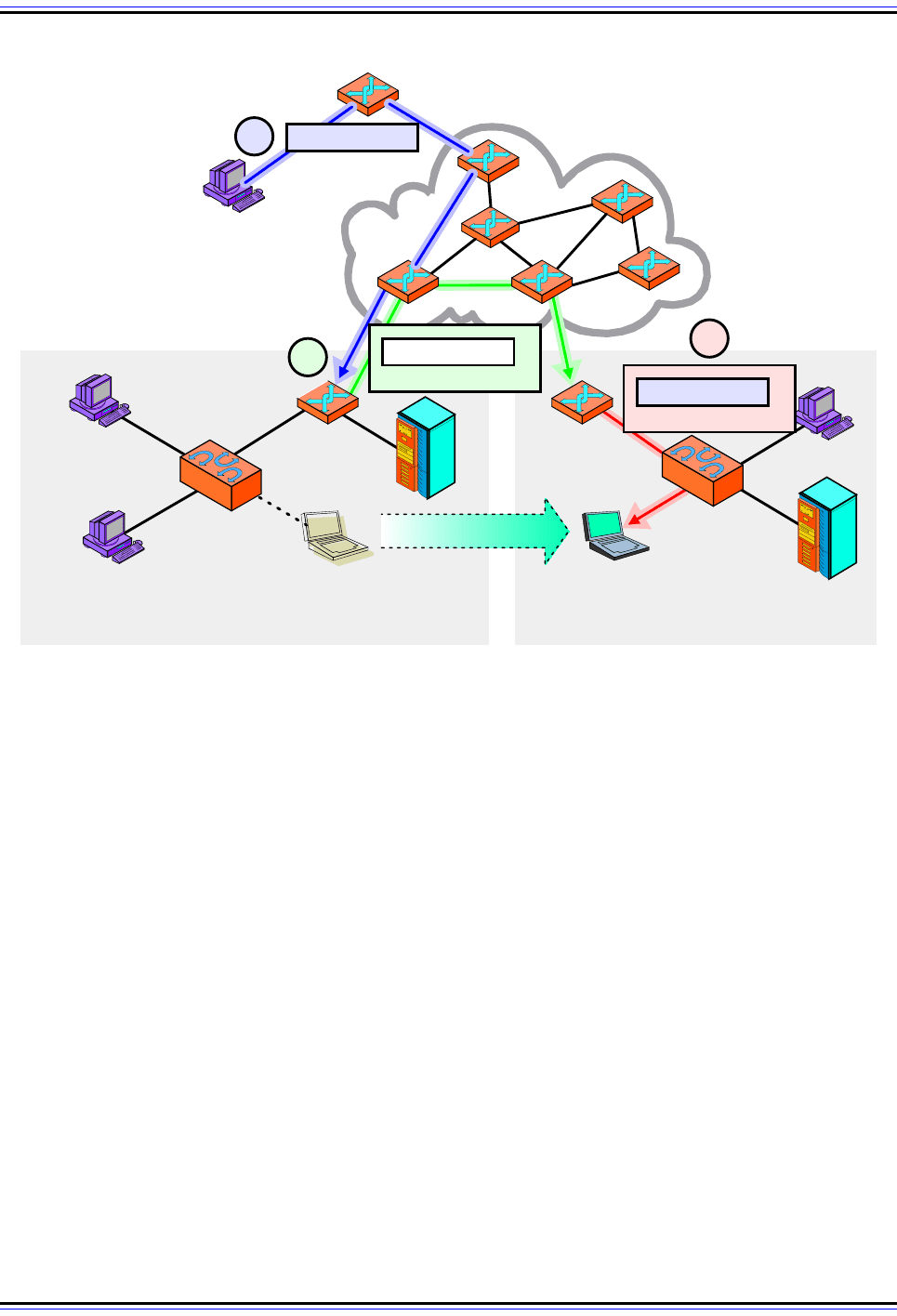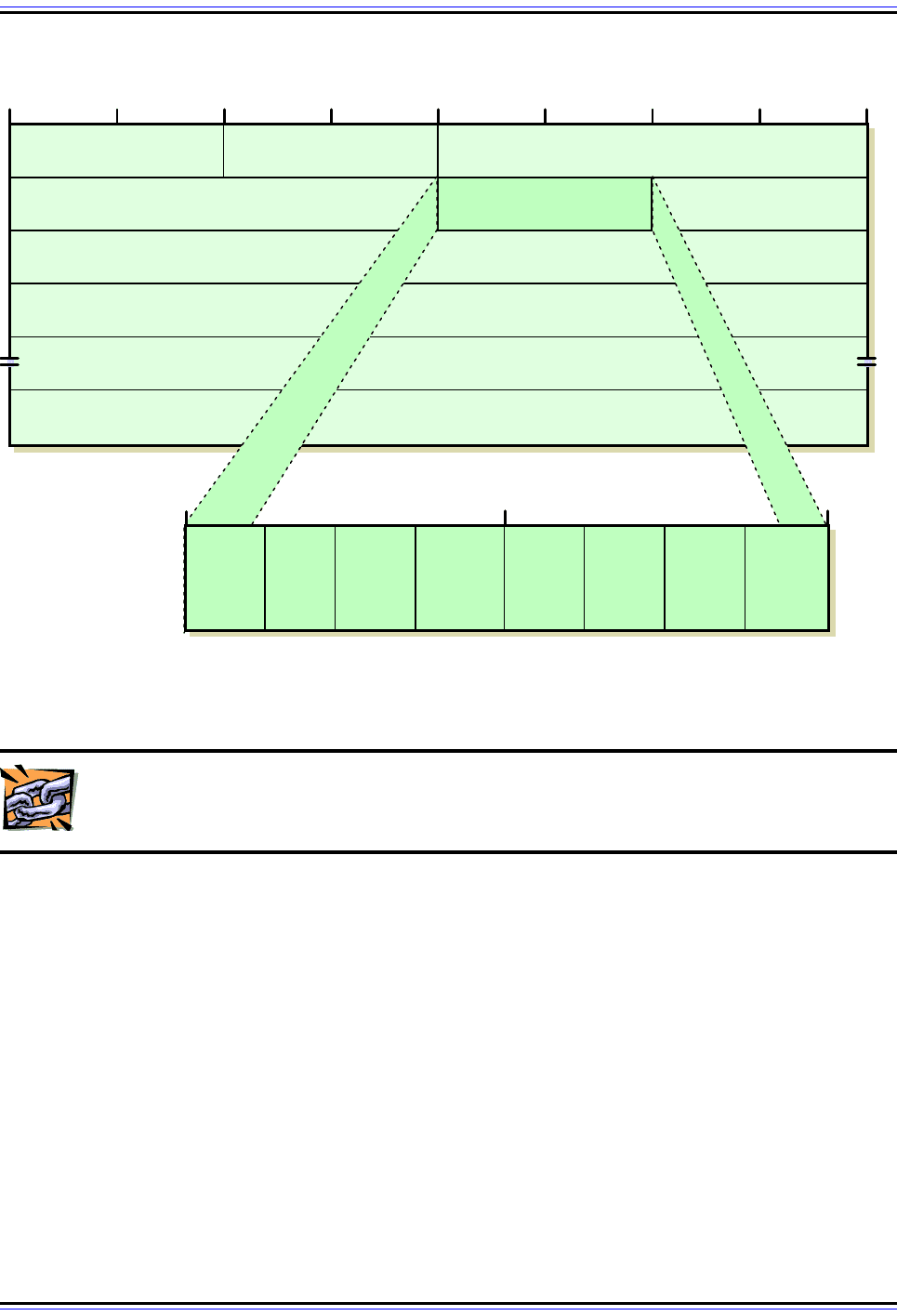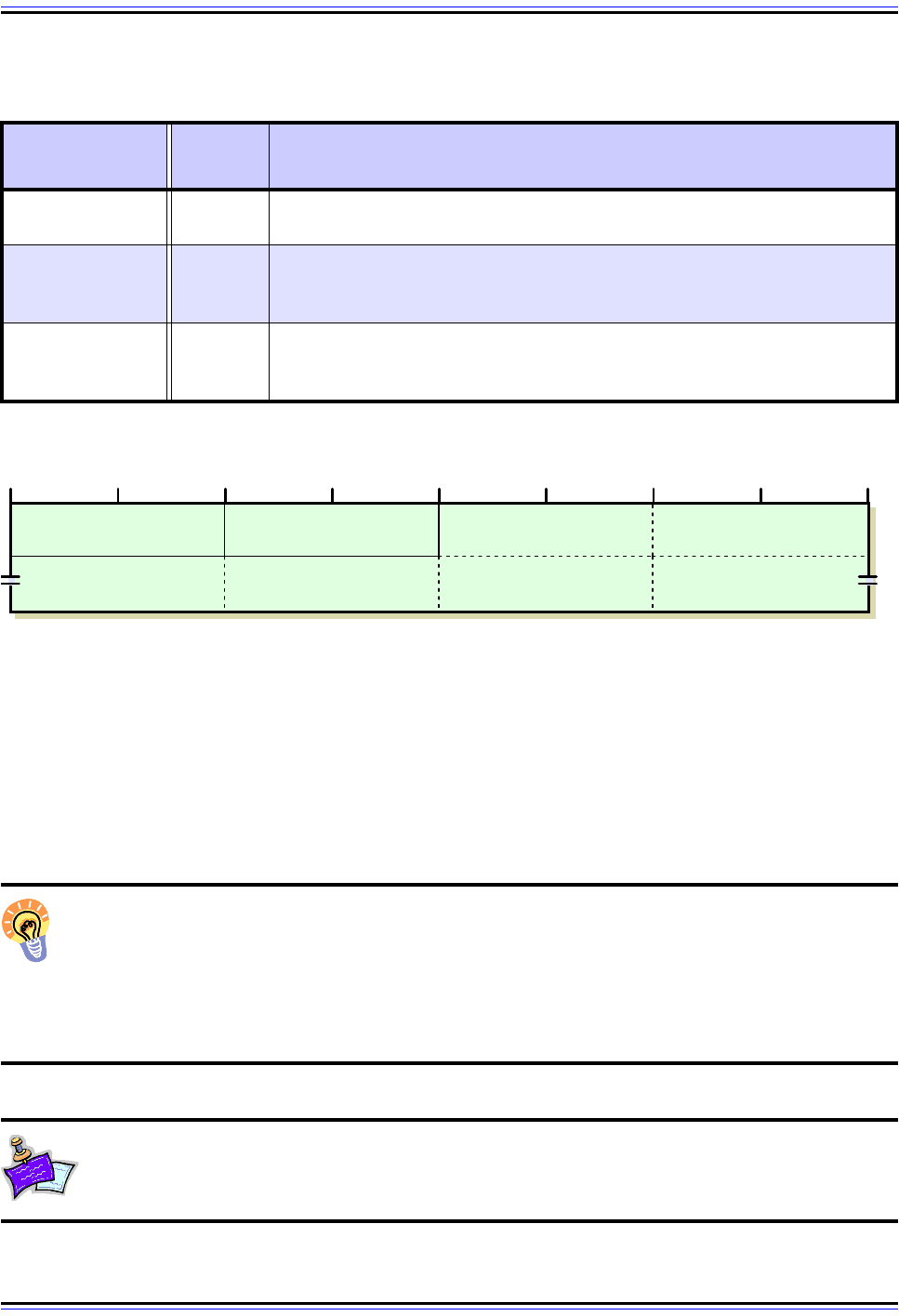Charles M. Kozierok The TCP-IP Guide
Подождите немного. Документ загружается.


The TCP/IP Guide - Version 3.0 (Contents) ` 581 _ © 2001-2005 Charles M. Kozierok. All Rights Reserved.
In our consultant analogy, this type of care-of address is like forwarding from the London
post office to the Tokyo post office. The London personnel would take a letter for John
Smith sent to his London address, and repackage it for delivery to “John Smith, care of the
Tokyo post office”. The Tokyo post office (or John Smith himself) would need to worry about
the last leg of the delivery.
Co-Located Care-Of Address
This is a care-of address assigned directly to the mobile node using some means external
to Mobile IP. For example, it may be assigned on the foreign network manually, or automat-
ically using DHCP. In this situation, the care-of address is used to forward traffic from the
home agent directly to the mobile node. This was the type of address shown in Figure 128.
In our consultant analogy, this is like John Smith obtaining a temporary address for his use
while in Tokyo. The London post office would forward directly to his Tokyo address. They
would not specifically send it to the Tokyo post office (though of course that PO would
handle the mail at some point).
Key Concept: In Mobile IP, each mobile device uses a temporary, care-of address
while on a foreign network. A co-located care-off address is one that is assigned
directly to the mobile node, and enables direct delivery of datagrams to the node.
The alternative is to use a foreign agent care-of address. In this situation the mobile node
actually uses the IP address of the foreign agent; datagrams are sent to the foreign agent,
which delivers them to the mobile node.
Advantages and Disadvantages of the Care-Of Address Types
The foreign agent care-of address is considered the type used in “classical” Mobile IP,
where there is both a home agent and a foreign agent. While it seems less efficient than the
co-located address method, it offers some important advantages. A key one is that the
same foreign agent care-of address can be used for all mobile nodes visiting that network.
Datagrams for all mobile nodes on that network are sent to the foreign agent, which
completes the delivery to the individual nodes. Since the mobile nodes use the foreign
agent's address, no extra addresses or extra work are required for each mobile node.
The co-located care-of address has the advantage that traffic can be forwarded directly
from the home agent to the mobile node. In this type of arrangement, it is possible for a
Mobile IP device to travel to a foreign network where there is no Mobile-IP-aware router to
act as a foreign agent. This does mean, however, that the Mobile IP implementation must
include all the functions of communicating with the home agent that the foreign agent
normally performs.
When co-located care-of addresses are used, an issue is how the temporary address is
obtained. In many foreign networks automatic assignment of an IP address using
something like DHCP may be possible, but if not, a temporary IP address would need to be

The TCP/IP Guide - Version 3.0 (Contents) ` 582 _ © 2001-2005 Charles M. Kozierok. All Rights Reserved.
assigned. Either way, some of the foreign network's limited IP address space would need to
be set aside for mobile nodes, each of which would use an address while present on the
network. In some cases this could lead to an address depletion issue.
Foreign agent care-of addressing is usually preferred due to its more automatic nature,
when a foreign agent is present on the visited network. Considering that all datagrams will
need to go through some router on the foreign network to reach the mobile node anyway,
we might as well save the extra IP addresses. Co-located care-of addresses would be used
when there is no foreign agent, or might be practical for long term connections even when a
foreign agent is present.
Figure 129: Mobile IP Operation With A Foreign Agent “Care-Of” Address
This diagram is similar to Figure 128, except that instead of the mobile node having a co-located (distinct) IP
address as in that example, here the mobile node is using a foreign agent care-of address. This means that
the node’s care-of address is actually that of the foreign agent itself. Step #1 is the same as in Figure 128, but
in step #2 the home agent forwards not to the mobile node directly, but to the foreign agent (since that router
is the one whose IP address the mobile is using). In step #3 the foreign agent strips off the home agent’s
packaging and delivers the original datagram to the mobile node. This is typically done using whatever layer
two (LAN or wireless LAN) technology connects the mobile node and foreign agent together.
Foreign Network (Tokyo)
210.4.79.0/24
Home Network (London)
71.13.204.0/24
Mobile Node
Home Location
Home Address 71.13.204.20
Home
Age nt
Foreign
Age nt
210.4.79.2
To: 71.13.204.20
Mobile Node
Foreign Location
Care-Of Address 210.4.79.2
Tunnel To: 210.4.79.2
L2 Dest: Mobile Node
#1
Remote
Client
Addess 56.1.78.22
#2
#3
To: 71.13.204.20
To: 71.13.204.20

The TCP/IP Guide - Version 3.0 (Contents) ` 583 _ © 2001-2005 Charles M. Kozierok. All Rights Reserved.
Remember that the care-of address represents only the destination to which mobile node
datagrams are forwarded. Foreign agents provide services other than forwarding, so it is
possible for a mobile node to use a co-located care-of address even when a foreign agent
is present, while continuing to take advantage of the other foreign agent services.
Key Concept: In Mobile IP, co-located care-of addresses have the advantage of
flexibility, but require each device to have a unique IP address on the remote
network. Foreign agent care-of addresses have the chief advantage of allowing
many mobile devices on a foreign network without each requiring a distinct IP address.
For more information on how datagrams are forwarded between the home agent and the
mobile node's care-of address, see the topic on Mobile IP encapsulation and tunneling.
Mobile IP Agent Discovery, and Agent Advertisement and Solicitation
Messages
When a mobile node is first turned on, it cannot assume that it is still “at home” the way
normal IP devices do. It must first determine where it is, and if it is not at home, begin the
process of setting up datagram forwarding from its home network. This process is accom-
plished by communicating with a local router serving as an agent, through the process
called agent discovery.
Agent Discovery Process
Agent discovery encompasses the first three steps in the simplified five-step Mobile IP
operational summary I gave in the topic on general operation. The main goals of agent
discovery include the following:
☯ Agent/Node Communication: Agent discovery is the method by which a mobile node
first establishes contact with an agent on the local network to which it is attached.
Messages are sent from the agent to the node containing important information about
the agent; a message can also be sent from the node to the agent asking for this infor-
mation to be sent.
☯ Orientation: The node uses the agent discovery process to determine where it is.
Specifically, it learns whether it is on its home network or a foreign network by identi-
fying the agent that sends it messages.
☯ Care-Of Address Assignment: The agent discovery process is the method used to
tell a mobile node the care-of address it should use, when foreign agent care-of
addressing is used.
Mobile IP agents are routers that have been given additional programming to make them
“Mobile IP aware”. The communication between a mobile node and the agent on its local
network is basically the same as the normal communication required between a device on
an IP network and its local router, except more information needs to be sent when the
router is an agent.

The TCP/IP Guide - Version 3.0 (Contents) ` 584 _ © 2001-2005 Charles M. Kozierok. All Rights Reserved.
Agent Advertisement and Agent Solicitation Messages
Provision already exists for exchanges of data between a router and a node, in the form of
ICMP messages that are used for the regular IP router discovery process. Two messages
are used for this purpose: Router Advertisement messages that let routers tell local nodes
that they exist and describe their capabilities, and Router Solicitation messages that let a
node prompt a router to send an advertisement. These are described in their own topic in
the ICMP section.
Given the similarity to normal router discovery, it made sense to implement agent discovery
as a modification to the existing process rather than set up a whole new system. The
messages used in the agent discovery process are:
☯ Agent Advertisement: This is a message transmitted regularly by a router acting as a
Mobile IP agent. It consists of a regular Router Advertisement message that has one
or more extensions added that contain Mobile-IP-specific information for mobile
nodes.
☯ Agent Solicitation: This message can be sent by a mobile IP device to nudge a local
agent to send an Agent Advertisement.
The use of these messages is described in the Mobile IP standard in detail, and unsurpris-
ingly, is very similar to how regular Router Advertisement and Router Solicitation messages
are employed. Agents are normally configured to send out Agent Advertisements on a
regular basis, with the rate set to ensure reasonably fast contact with mobile nodes without
consuming excessive network bandwidth. They are required to respond to any Agent Solic-
itation messages they receive by sending an Advertisement. It is possible that some agents
may be configured to send Advertisements only upon receipt of a Solicitation.
Mobile nodes are required to accept and process Agent Advertisements. They distinguish
these from regular Router Advertisements by looking at the size of the message. They then
parse the extension(s) to learn the capabilities of the local agent. They determine whether
they are on their home network or a foreign network, and in the case of a foreign agent, how
the agent should be used. Mobile nodes are required to use Agent Advertisements to detect
when they have moved, using one of two algorithms defined in the standard, and also to
detect when they have returned back to their home network after they have been traveling.
They are also required to be able to send Agent Solicitation messages if they don't receive
an Agent Advertisement after a certain period of time. They are restricted to sending these
only infrequently, however, again to keep traffic manageable.
Now let's look at the formats of the two message types.
Agent Solicitation Message Format
Let’s start with the Agent Solicitation message because it is much simpler. In fact, there is
no new message format defined for this at all; it is identical to the format of a Router Solici-
tation message.

The TCP/IP Guide - Version 3.0 (Contents) ` 585 _ © 2001-2005 Charles M. Kozierok. All Rights Reserved.
The reason no new message type is required here is that a solicitation is an extremely
simple message: “hey, if there are any routers out there, please tell me who you are and
what you can do”. No extra Mobile IP information needs to be sent. When a regular IP
router receives a Router Solicitation it will send a Router Advertisement, but a Mobile IP
router automatically sends the longer Agent Advertisement instead when prompted by any
solicitation, whether it comes from a Mobile IP node or a regular IP device.
Agent Advertisement Message Format
The Agent Advertisement begins with the normal fields of an ICMP Router Advertisement
message. The destination of the message is either the “all devices” multicast address
(224.0.0.1) if multicast is supported on the local network, or the broadcast address
(255.255.255.255) otherwise. The Router Address fields are filled in with the address(es) of
the agent.
Note: It is possible that a device may wish to advertise its ability to handle Mobile
IP messages, but not act as a regular router. In this case it changes the normal
Code field in the header of the Router Advertisement message from 0 to 16.
Following the regular fields, one or more extensions are added to the message format.
There are three extensions defined: the Mobility Agent Advertisement Extension, Prefix-
Lengths Extension, and One-Byte Padding Extension.
Mobility Agent Advertisement Extension
This is the main extension used to convey Mobile IP capabilities of the agent to mobile
nodes on the local network. It contains numerous fields used as part of the various
processes described in this overall section on Mobile IP.
The structure of the Mobility Agent Advertisement Extension is described in Table 82 and
shown graphically in Figure 130.

The TCP/IP Guide - Version 3.0 (Contents) ` 586 _ © 2001-2005 Charles M. Kozierok. All Rights Reserved.
Table 82: Mobile IP Mobility Agent Advertisement Extension Format
Field Name
Size
(bytes)
Description
Type 1
Extension Type: Identifies the Agent Advertisement extension type. For
the Mobility Agent Advertisement Extension, it is set to 16.
Length 1
Length: Length of the extension in bytes, excluding the Type and Length
fields. Thus, it is equal to 6 plus 4 for each care-of address in the message.
Sequence
Number
2
Sequence Number: A sequential counter set to zero when the router
initializes and then incremented for each advertisement sent out.
Registration
Lifetime
2
Registration Lifetime: The maximum length of time, in seconds, the agent
is willing to accept for registration requests. A value of 65,535 (all ones)
means “infinite”. Note that this field is for registration only and has no
relation to the regular Lifetime field in the regular Router Advertisement
part of the message.
Flags 1
Reserved 1 Reserved: Sent as zero and ignored by recipient.
Care-Of
Addresses
Variable
(4 per
address)
Care-Of Addresses: Zero or more addresses provided by a foreign agent
for a mobile node to use as a foreign agent care-of address. A foreign
agent must always provide at least one address in its advertisement; a
router that cannot act as a foreign agent will typically omit this field.
Fl
ags:
A
one-
b
y
t
e
fi
e
ld
con
t
a
i
n
i
ng severa
l
i
n
f
orma
ti
ona
l
fl
ags
th
a
t
convey
specific information about the agent's capabilities and status. There are
seven one-bit flags, which when set to one convey the meanings given in
the table below:
Subfield
Name
Size
(bytes)
Description
R
1/8
(1 bit)
Registration Required: The mobile node must
register through the foreign agent, even when
using a co-located care-of address.
B
1/8
(1 bit)
Busy: The agent is currently too busy to accept
further registrations from mobile nodes.
H
1/8
(1 bit)
Home Agent: The agent is willing to function as a
home agent on this link (it will forward datagrams,
etc.) Note that a device can offer services as both
a home agent and a foreign agent.
F
1/8
(1 bit)
Foreign Agent: The agent is willing to function as
a foreign agent. Again, a device can act as both a
home agent and a foreign agent simultaneously.
M
1/8
(1 bit)
Minimal Encapsulation: The agent can receive
tunneled datagrams using minimal encapsulation.
G
1/8
(1 bit)
GRE Encapsulation: The agent can receive
tunneled datagrams using GRE encapsulation.
r
1/8
(1 bit)
Reserved: Not used; sent as zero.
T
1/8
(1 bit)
Reverse Tunneling: The agent supports reverse
tunneling.

The TCP/IP Guide - Version 3.0 (Contents) ` 587 _ © 2001-2005 Charles M. Kozierok. All Rights Reserved.
Related Information: See the topic on Mobile IP encapsulation for more on
minimal and GRE encapsulation and reverse tunneling.
Prefix-Lengths Extension
This is an optional extension that tells a mobile node the prefix length(s) of the router
address(es) contained in the regular portion of the Agent Advertisement message; that is,
the Router Address field in the regular Router Advertisement part of the message. The
prefix length is another term for the number of bits in an IP address is the network ID, so
this tells the node the network ID in each of the router's addresses
Figure 130: Mobile IP Mobility Agent Advertisement Extension Format
This extension appears after the normal fields of a Router Advertisement message, as shown in Figure 148.
Extension Type = 16 Length Sequence Number
Registration Lifetime Flags Reserved
4 8 12 16 20 24 28 320
...
Regis-
tration
Required
(R)
Busy (B)
Home
Agent (H)
Foreign
Agent (F)
Minimal
Encap-
sulation
(M)
GRE
Encap-
sulation
(G)
Res er v ed
(r)
Rev er s e
Tunneling
(T)
48
0
Care-Of Address 1
Care-Of Address 2
Care-Of Address #N

The TCP/IP Guide - Version 3.0 (Contents) ` 588 _ © 2001-2005 Charles M. Kozierok. All Rights Reserved.
The format of the Prefix-Lengths Extension is shown in Table 83 and also in Figure 131.
One-Byte Padding Extension
Some implementations require ICMP messages to be an even number of bytes, so a byte
of padding is needed. (The One-Byte Padding Extension is just a single byte of all zeroes.
No tables or figures needed for that!)
Key Concept: Mobile IP agent discovery is the process by which a mobile node
determines where it is located and establishes contact with a home or foreign agent.
Routers that can function as agents regularly send Agent Advertisement messages
to indicate their capabilities, which are modified versions of regular Router Advertisements.
A mobile node can also send an Agent Solicitation to request the sending of an Adver-
tisement, which is the same as regular Router Solicitation.
Note: Mobile IP does not include any provisions for authentication of Agent Adver-
tisement and Agent Solicitation messages. They may be authenticated using
IPSec, of course, if that has been implemented.
Table 83: Mobile IP Prefix-Lengths Extension Format
Field Name
Size
(bytes)
Description
Type 1
Extension Type: Identifies the Agent Advertisement extension type. For
the Prefix-Lengths Extension, it is set to 19.
Length 1
Length: Length of the extension in bytes, excluding the Type and Length
fields. Thus, it is equal to the number of prefix lengths (since each takes 1
byte).
Prefix Lengths
Variable
(1 per
length)
Prefix Lengths: One prefix length number for each router address in the
regular, Router Advertisement portion of the Agent Advertisement.
Figure 131: Mobile IP Prefix-Lengths Extension Format
This extension appears after the normal fields of a Router Advertisement message, as shown in Figure 148.
Extension Type = 19 Length Prefix Length #1 Prefix Length #2
Prefix Length #3 Prefix Length #4
...
Prefix Length #N
4 8 12 16 20 24 28 320

The TCP/IP Guide - Version 3.0 (Contents) ` 589 _ © 2001-2005 Charles M. Kozierok. All Rights Reserved.
Mobile IP Home Agent Registration and Registration Messages
Once a mobile node has completed agent discovery, it knows whether it is on its home
network or a foreign network. If on its home network it communicates as a regular IP
device, but if on a foreign network it must activate Mobile IP. This requires that it commu-
nicate with its home agent so information and instructions can be exchanged between the
two. This process is called home agent registration, or more simply, just registration.
The main purpose of registration is to actually start Mobile IP working. The mobile node
must contact the home agent and tell it that it is on a foreign network and request that
datagram forwarding be turned on. It also must let the home agent know its care-of address
so the home agent knows where to send the forwarded datagrams. The home agent in turn
needs to communicate various types of information back to the mobile node when regis-
tration is performed. Note that the foreign agent is not really involved in registration, except
perhaps to relay messages, as we will see.
Mobile Node Registration Events
Successful registration establishes what is called in the standard a mobility binding between
a home agent and a mobile node. For the duration of the registration, the mobile node's
regular home address is tied to its current care-of address and the home agent will encap-
sulate and forward datagrams addressed to the home address over to the care-of address.
The mobile node is supposed to manage its registration and handle various events using
several actions:
☯ Registration: The mobile node initiates a registration when it first detects it has
moved from its home network to a foreign network.
☯ Deregistration: When the mobile node returns home, it should tell the home agent to
cancel forwarding, a process called deregistration.
☯ Reregistration: If the mobile node moves from one foreign network to another, or if its
care-of address changes, it must update its registration with the home agent. It also
must do so if its current registration is about to expire, even if it remains stationary on
one foreign network.
Each registration is established only for a specific length of time, which is why regular rereg-
istration is required whether the device moves or not. Registrations are time-limited to
ensure that they do not become stale. If, for example, a node forgets to de-register when it
returns home, the datagram forwarding will eventually stop when the registration expires.
New Registration Request and Registration Reply Messages
To perform registration, two new message types have been defined in Mobile IP: the Regis-
tration Request and the Registration Reply. Each of these does what you would expect from
its name. Interestingly, these are not ICMP messages like the ones used in agent discovery;
they are User Datagram Protocol (UDP) messages. Thus, technically speaking, registration
is performed at a higher layer than the rest of Mobile IP communication. Agents listen for
Registration Requests on well-known UDP port #434, and respond back to mobile nodes
using whatever ephemeral port the node used to send the message.

The TCP/IP Guide - Version 3.0 (Contents) ` 590 _ © 2001-2005 Charles M. Kozierok. All Rights Reserved.
The formats of these two messages are described later in this topic.
Registration Procedures
There are two different procedures defined for registration, depending on the type of care-of
address used by the mobile node and other specifics we will get into shortly. The first is the
direct registration method, which has just two steps:
1. Mobile node sends Registration Request to home agent.
2. Home agent sends Registration Reply back to mobile node.
In some cases, however, a slightly more complex process is required, where the foreign
agent conveys messages between the home agent and the mobile node. In this situation,
the process has four steps:
1. Mobile node sends Registration Request to foreign agent.
2. Foreign agent processes Registration Request and forwards to home agent.
3. Home agent sends Registration Reply to foreign agent.
4. Foreign agent processes Registration Reply and sends back to mobile node.
The first, simpler method is normally used when a mobile node is using a co-located care-of
address. In that situation, the node can easily communicate directly with the home agent,
and the mobile node is also set up to directly receive information and datagrams from the
home agent. When there is no foreign agent, this is obviously the method that must be
used. It is also obviously the method used when a mobile node is de-registering with its
home agent after it arrives back on the home network.
The second method is required when a mobile node is using a foreign care-of address.
Recall that in this situation, the mobile node doesn't have its own unique IP address at all; it
is using a shared address given it by the foreign agent, which precludes direct communi-
cation between the node and the home agent. Also, if a mobile node receives an Agent
Advertisement with the “R” flag set, it also should go through the foreign agent, even if it has
a co-located care-of address.
Note that the foreign agent really is just a “middleman”; the exchange is still really between
the home agent and the mobile node. However, the foreign agent can deny registration if
the request violates whatever rules are in place for using the foreign network. It is for this
reason that some foreign agents may require that they be the conduit for registrations even
if the mobile node has a co-located care-of address. Of course, if the foreign agent can't
contact the home agent the registration will not be able to proceed.
The description above is really a highly simplified explanation of the basics of registration.
The Mobile IP standard specifies many more details on exactly how agents and nodes
perform registration, including particulars on when requests and replies are sent, how to
handle various special conditions such as invalid requests, rules for how home agents
maintain a table of mobility bindings, and much more. The standard covers the definition of
extensions to the regular registration messages to support authentication, which is required
